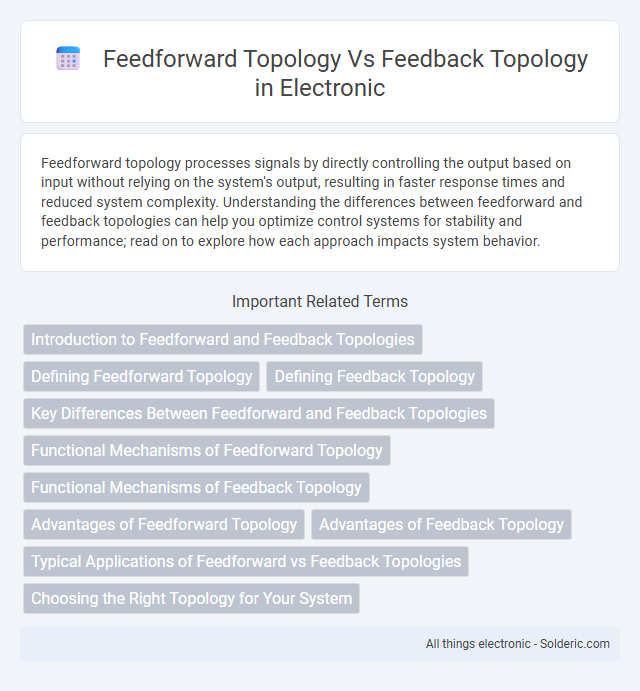Feedforward topology processes signals by directly controlling the output based on input without relying on the system's output, resulting in faster response times and reduced system complexity. Understanding the differences between feedforward and feedback topologies can help you optimize control systems for stability and performance; read on to explore how each approach impacts system behavior.
Comparison Table
| Feature | Feedforward Topology | Feedback Topology |
|---|---|---|
| Definition | Signal flows in one direction from input to output | Output loops back to input for self-correction |
| Control | Open-loop control, no error correction | Closed-loop control, uses error feedback |
| Stability | Generally stable, no oscillations | Can be unstable; requires careful design |
| Complexity | Simple design, less components | More complex, needs sensors and controllers |
| Response Time | Fast response, no delay from feedback | Slower response due to feedback processing |
| Accuracy | Less accurate, no dynamic error correction | High accuracy, continuously adjusts output |
| Applications | Feedforward neural networks, signal processing without error correction | Control systems, thermostats, amplifiers, adaptive systems |
Introduction to Feedforward and Feedback Topologies
Feedforward topology processes input signals through a unidirectional path to the output without using output information for correction, enhancing stability and speed in control systems. Feedback topology continuously adjusts the input based on the output signal to reduce errors and maintain system accuracy, commonly used in automatic control and electronic circuits. Both topologies are fundamental in control engineering, where feedforward minimizes disturbances, and feedback ensures system precision and robustness.
Defining Feedforward Topology
Feedforward topology involves a unidirectional flow of signals from input to output without loops, ensuring predictable system behavior. This contrasts feedback topology, where outputs are fed back into the system to influence future inputs, enabling adaptive control but introducing complexity. In your system design, choosing feedforward topology can improve stability and simplify analysis by eliminating feedback-induced oscillations.
Defining Feedback Topology
Feedback topology is a control system structure where the output signal is continuously monitored and compared to the input or desired reference, enabling automatic adjustments to minimize error and stabilize the system's performance. This approach improves accuracy and robustness against disturbances by using the measured output to influence the input signal through a feedback loop. Understanding feedback topology helps optimize your control design for enhanced stability and precision in dynamic environments.
Key Differences Between Feedforward and Feedback Topologies
Feedforward topology processes signals in a unidirectional flow, enhancing system stability by avoiding loop-induced oscillations, whereas feedback topology relies on output signals fed back into the input to self-correct and maintain desired performance. Feedforward designs offer faster response times with less complexity but lack the adaptability of feedback systems, which can dynamically compensate for disturbances and uncertainties. Your choice between these topologies depends on the required balance of speed, stability, and adaptability in your specific control or signal processing application.
Functional Mechanisms of Feedforward Topology
Feedforward topology operates by processing input signals through a sequence of layers without looping back, enabling direct and efficient signal propagation for tasks such as pattern recognition and classification. This mechanism enhances performance by minimizing delay and preventing oscillations, which commonly occur in feedback systems. The absence of feedback loops in feedforward networks allows for stable, unidirectional data flow, facilitating straightforward training and faster convergence in neural networks.
Functional Mechanisms of Feedback Topology
Feedback topology operates by continuously monitoring the output signal and comparing it with the input or desired reference, enabling automatic error correction to stabilize system performance. This mechanism adjusts the system parameters in real time to minimize deviations caused by disturbances or internal variations, enhancing accuracy and robustness. Understanding these functional mechanisms helps you design control systems that maintain consistent operation under varying conditions.
Advantages of Feedforward Topology
Feedforward topology offers superior stability and faster response times compared to feedback topology by eliminating loops that can cause oscillations or delays. Your system benefits from improved predictability and easier design analysis since feedforward control anticipates disturbances without relying on output measurements. This approach enhances performance in environments where precision and rapid adjustments are critical.
Advantages of Feedback Topology
Feedback topology offers enhanced stability and improved accuracy in control systems by continuously adjusting the output based on real-time performance. It effectively reduces errors caused by disturbances and component variations, ensuring reliable operation under varying conditions. Your system benefits from increased robustness and adaptability, making feedback topology ideal for applications requiring precise control and consistent output quality.
Typical Applications of Feedforward vs Feedback Topologies
Feedforward topology is typically applied in control systems requiring rapid response and minimal delay, such as robotics motion control and audio signal processing, where predicting disturbances enhances system performance without relying on error correction. Feedback topology is prevalent in temperature regulation, motor speed control, and industrial automation, as it continuously monitors output to correct deviations, ensuring stability and accuracy in dynamic environments. Applications demanding precision and adaptability often combine both topologies to optimize control reliability and response time.
Choosing the Right Topology for Your System
Selecting the appropriate topology for your system depends on the desired control dynamics and stability requirements. Feedforward topology offers predictive control by anticipating changes, minimizing error before it occurs, which suits systems with predictable disturbances. Feedback topology provides corrective control by continuously adjusting based on output, making it ideal for systems requiring robust error compensation and adaptability to unforeseen variations.
feedforward topology vs feedback topology Infographic

 solderic.com
solderic.com